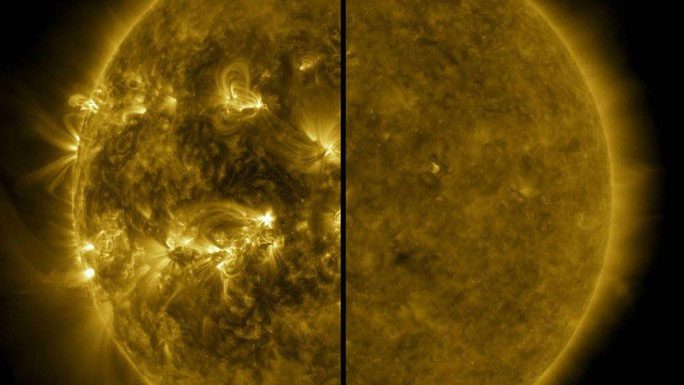A series of captivating images that people encountered in 2023, from hybrid solar eclipses, “light butterflies” to pink auroras, are actually The Sun is signaling that it is “about to reverse”.
According to Live Science, the Sun will reach its peak in the 11-year cycle earlier than initially expected (in 2025), specifically by the end of 2023.
This event will be marked by the “solar reversal” phenomenon – where the chaos in its magnetosphere reaches extreme tension and resolves by swapping the North and South magnetic poles.

The Sun in its explosive phase (left) and calm phase in the 11-year cycle – (Photo: NASA).
This phenomenon is crucial for us – a planet that heavily relies on the health of this mother star to sustain life – but it also causes quite a bit of trouble. In 2023, 10 observable signs from Earth confirmed this impending reversal.
- First, there has been a rapid increase in the number of sunspots, exceeding twice the initial predictions by NASA and the National Oceanic and Atmospheric Administration (NOAA) early this year.
- Second, from those sunspots, the strongest X-class solar flares have been continuously emitted, which led to widespread shortwave radio blackouts in February, accompanied by a coronal mass ejection (CME).
- Third, geomagnetic storms have been so strong that unusual pink auroras appeared in the U.S. at the end of March.
- Fourth, the temperature in the thermosphere (the second layer in the atmosphere) is rising.
- Fifth, there was a rare hybrid solar eclipse on April 20, generated by more than usual light rays from the Sun.
- Sixth, there have been continuous light tornadoes erupting on the Sun, with some as large as… 14 times the Earth. Seventh, there are super-strong polar vortices on the Sun. Eighth, there was a “CME butterfly” on March 10. Ninth, a plasma burst spanning 1 million miles was emitted in September 2022. Tenth, there was a “plasma waterfall” like a crown on March 9.
The last five phenomena were recorded by NASA’s Solar Dynamics Observatory (SDO).
Certainly, the reversal at the end of 2023 will bring many geomagnetic storms and CME bombardments to the planets of the Sun – including Earth.
The good news is that you will not experience a storm in the literal sense, as humanity does not feel geomagnetic storms, and we have already “endured” them every 11 years. However, it could affect some technologies, requiring careful preparation.
These events will disrupt power grids, cause shortwave radio blackouts in some areas, affect navigation systems – particularly aerospace, and impact some species, for example, causing migratory birds to “get lost.” Therefore, international efforts in space weather forecasting and early warning are crucial.
For instance, the American space company SpaceX suffered significant losses in 2022 when it launched over 40 Starlink satellites right as a geomagnetic storm hit, causing 40 of them to fall back and burn up in the Earth’s atmosphere.
Nonetheless, this will be a rare occasion for aurora enthusiasts, as it is sure to be bright, colorful, and reach lower latitudes than usual.





















































